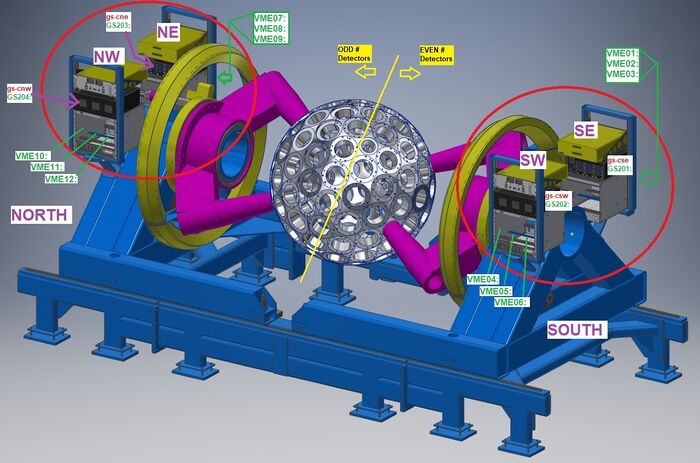DAQ system: Difference between revisions
No edit summary |
No edit summary |
||
| Line 1: | Line 1: | ||
<imagemap> | <imagemap> | ||
Image:GammasphereDAQupgrade.jpg|700px|center|thumb|DAQ System circled in red; one rack for each of the four "hemispheres" of Gammasphere | Image:GammasphereDAQupgrade.jpg|700px|center|thumb|Figure 1. DAQ System circled in red; one rack for each of the four "hemispheres" of Gammasphere | ||
poly 135 204 209 219 258 192 250 266 213 293 137 268 [[VME Crates]] | poly 135 204 209 219 258 192 250 266 213 293 137 268 [[VME Crates]] | ||
poly 904 385 977 402 1030 373 1029 438 979 470 904 452 [[VME Crates]] | poly 904 385 977 402 1030 373 1029 438 979 470 904 452 [[VME Crates]] | ||
| Line 19: | Line 19: | ||
The DAQ system prior to upgrades consisted of VME crates, IOC Modules, Digitizers and Trigger Modules. There were two types of Digitizers (Master and Slave) and well as Trigger (Master and Router). In the current version of the upgraded Gammasphere DAQ system, some of the old hardware is still used, but in a different way. All channels in all digitizers run continuously. When discriminator logic marks leading edges of gamma-ray signals, energy sums, timing and other data are stored in a header identifying the event. If the event is selected for readout by the trigger system, the header and a programmable amount of waveform is transferred from the channel to the board-wide FIFO (first in, first out) data holder. The IOC scans the FIFOs to see if there is data to read out. If so, the IOC reads it out into buffers. A program called “gtReceiver” sends messages to each IOC when the receiver is ready for more data. The IOC then breaks apart buffers into UDP packets and sends them to gtReceiver. The gtReceiver program then routes the packets to files that may be organized by digitizer or by channel. | The DAQ system prior to upgrades consisted of VME crates, IOC Modules, Digitizers and Trigger Modules. There were two types of Digitizers (Master and Slave) and well as Trigger (Master and Router). In the current version of the upgraded Gammasphere DAQ system, some of the old hardware is still used, but in a different way. All channels in all digitizers run continuously. When discriminator logic marks leading edges of gamma-ray signals, energy sums, timing and other data are stored in a header identifying the event. If the event is selected for readout by the trigger system, the header and a programmable amount of waveform is transferred from the channel to the board-wide FIFO (first in, first out) data holder. The IOC scans the FIFOs to see if there is data to read out. If so, the IOC reads it out into buffers. A program called “gtReceiver” sends messages to each IOC when the receiver is ready for more data. The IOC then breaks apart buffers into UDP packets and sends them to gtReceiver. The gtReceiver program then routes the packets to files that may be organized by digitizer or by channel. | ||
<imagemap> | <imagemap> | ||
Image:DAQSystem.png|center|thumb|700px|Diagram of the DAQ system process. | Image:DAQSystem.png|center|thumb|700px|Figure 2. Diagram of the DAQ system process. | ||
rect 454 225 478 241 [[Gammasphere Detectors]] | rect 454 225 478 241 [[Gammasphere Detectors]] | ||
rect 550 225 575 242 [[Gammasphere Detectors]] | rect 550 225 575 242 [[Gammasphere Detectors]] | ||
Revision as of 16:27, February 27, 2023

Gammasphere's DAQ system (data acquisition system) is now placed on relay racks by each of its four "hemispheres". Each of the racks for the DAQ consists of a power supply, a collector box, and a VME crate. The data acquisition system observes, interprets, and modifies data taken from Gammasphere and appropriately presents it to the user.
When Gammasphere collects data, single-ended signals are first collected from the slope box for the Ge Center, Ge Sides, and BGO segment. The signals are converted to differential signals by the SBX, and are then sent to the collector box so the signals can properly be routed to the digitizers. The digitizers process and output the desired information to the user based upon their data specifications. The DAQ system is an FPGA-based design that provides communication hub interfacing the preamp, power board, dongle and slope box to EPICS through serial interface. Analog signal paths are completely software controlled.
DAQ System Function
The DAQ system prior to upgrades consisted of VME crates, IOC Modules, Digitizers and Trigger Modules. There were two types of Digitizers (Master and Slave) and well as Trigger (Master and Router). In the current version of the upgraded Gammasphere DAQ system, some of the old hardware is still used, but in a different way. All channels in all digitizers run continuously. When discriminator logic marks leading edges of gamma-ray signals, energy sums, timing and other data are stored in a header identifying the event. If the event is selected for readout by the trigger system, the header and a programmable amount of waveform is transferred from the channel to the board-wide FIFO (first in, first out) data holder. The IOC scans the FIFOs to see if there is data to read out. If so, the IOC reads it out into buffers. A program called “gtReceiver” sends messages to each IOC when the receiver is ready for more data. The IOC then breaks apart buffers into UDP packets and sends them to gtReceiver. The gtReceiver program then routes the packets to files that may be organized by digitizer or by channel.

DGS Commander EPICS Screens
This section contains an image map of DGS Commander and all subsequent EPICS screens.
Go back to Digital Gammasphere Upgrade Project